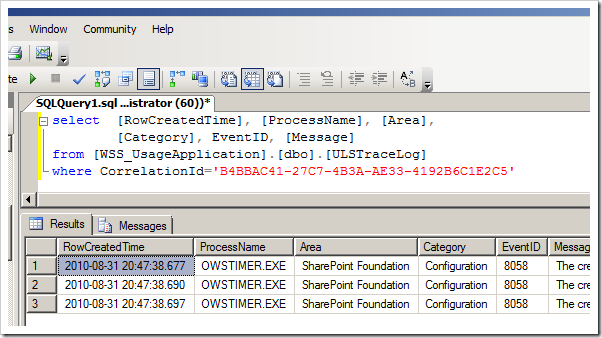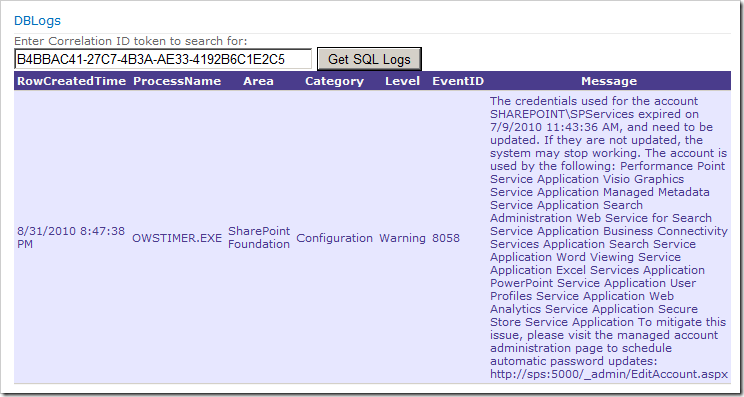Find error messages with a Correlation ID token in SharePoint 2010
2015-07-20 22:27
1176 查看
Using PowerShell to lookup a log message based on Correlation ID token
One of the quick-n-awesome ways to do this is to simply hook up a PowerShell console (SharePoint 2010 Management Shell) and then just write the following command (replace the <GUID> with the Correlation Id):get-splogevent | ?{$_Correlation -eq "<GUID>"}
This will give you the details about your specific error like this in the console:

You might want to be more precise and get more specific details out of your query, then you can try something like this:
get-splogevent | ?{$_.Correlation -eq "<GUID>"} | select Area, Category, Level, EventID, Message | Format-List
This will give you the details about your specific error like this with some juicy details:

Finally if you would want these messages to be put into a text or log file instead, you could just add the classic “>
C:Awesome.log” after the command like this:
get-splogevent | ?{$_.Correlation -eq "<GUID>"} | select Area, Category, Level, EventID, Message | Format-List > C:Awesome.log

On MSDN they have an overvoew of using SP-GetLogEvent which I would recommend!
Using SQL queries to find log message based on Correlation ID token
You can utilize the SQL logs database to fetch the specific error message based on Correlation id as well. In your logging DB (usually called WSS_Logging,but can be called something else if you’ve changed it) there is a view called ULSTraceLogwhich
you can query with a simple SQL query and fetch the results.
I’ve created a query to fetch the items from the logging database like this:
select [RowCreatedTime], [ProcessName], [Area],
[Category], EventID, [Message]
from [WSS_UsageApplication].[dbo].[ULSTraceLog]
where CorrelationId=< pre>'B4BBAC41-27C7-4B3A-AE33-4192B6C1E2C5'
This will render your results in the SQL Query window like this:

This can of course be implemented in a Web Part for your convenience as well (I’ve created a bunch of diag. and logging web parts that I’ve got deployed to Central Admin) that could look like this (this way you don’t need physical access to the ULS logs all
the time, but can do a quick lookup from the web part):

Get the current Correlation ID by using code
I got this piece of code from my good friend Wictor’s blog post. Thanks Wictor – this made my Logging-project moresatisfying!
With the following code you can fetch the current Correlation Id of a request.
Create a method (in my case called GetCurrentCorrelationToken()) to wrap up the functionality
of returning the current token like this:
public class CorrelationId
{[DllImport ("advapi32.dll")]public static extern uint EventActivityIdControl(uint controlCode,ref Guid activityId);
public const uint EVENT_ACTIVITY_CTRL_GET_ID = 1;
public static Guid GetCurrentCorrelationToken()
{Guid g = Guid .Empty;
EventActivityIdControl(EVENT_ACTIVITY_CTRL_GET_ID, ref g);
return g;
}
}
Then from wherever in your code you can simply call it by using this approach:
protected void Button1_Click(object sender, EventArgs e)
{Label1.Text = CorrelationId .GetCurrentCorrelationToken().ToString();
}
(Normally you might want this in a try/catch statement or something like that)

相关文章推荐
- python+M2Crypto+windows安装
- 如何快速学习C语言
- 股票学习(财务分析08)
- SharePoint 2013 开发教程
- 自动化运维工具之ansible(转)
- Implement strStr()
- Android精确适配不同的dpi和屏幕尺寸(附dimens按比例变化数字的工具类)
- vmstat 中swpd的意义
- Objective-C学习笔记 内存管理
- c# 强制杀掉进程
- 如何优雅的包装java写的桌面应用程序给客户
- 产品学习(一)——《用户体验要素》
- 拼接字符串——表格
- C\C++和Java 的区别(特别是在内存分配方面)
- 《鸟哥的Linux私房菜》第七章 Linux文件与目录管理
- LeetCode:Remove Nth Node From End of List
- 2. QT窗体间值的传递
- win7 关闭休眠命令
- 硬币问题
- Zepto.js源码分析
